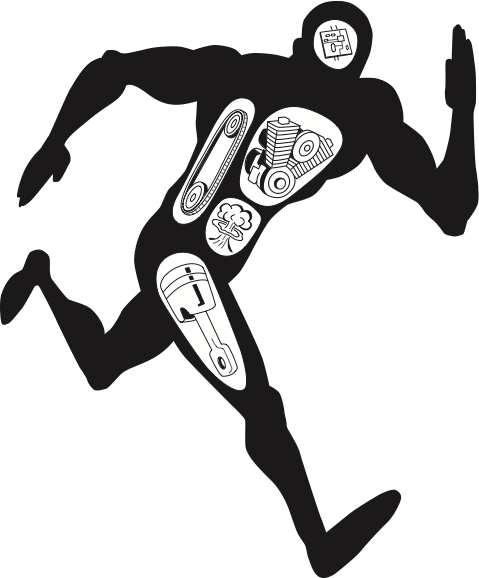Introduction to the Human Machine
The human body is a fascinating machine, composed of trillions of cells, hundreds of organs, and nearly a dozen organ systems, all working together in a magical dance to keep you upright and moving. Organ systems are groups of organs that interact to provide the body’s primary functions. For example the digestive system includes not only the stomach and intestines but other organs such as the liver, gallbladder and pancreas which are also part of the endocrine system. Each of these systems is highly complex, and the interactions between them are even more intricate. The interactions between systems become even more complex when we move beyond the normal range of functioning. Whether due to exercise, illness, or poor lifestyle choices, the body engages in remarkable processes just to keep us going. This process of returning the body to a normal state is referred to as homeostasis.
The human body consists of eleven primary organ systems, each with specific roles that contribute to our survival and well-being. These systems include the integumentary, muscular, skeletal, cardiovascular, respiratory, nervous, digestive, urinary, endocrine, lymphatic, reproductive, and integumentary systems. Oftentimes, for teaching purposes we present these systems as discrete. Such as the muscular or the skeletal systems. While this does make sense for teaching purposes, it is not the way the body’s organ systems interact.

For this article, each system will be framed by what systems in which they interact. Such as the neuromuscular or the musculoskeletal systems. The goal of this article is to provide an overview of each of these body systems and how they interact. Future articles will elaborate on specific systems and their interactions.
THE SYSTEMS OF LOCOMOTION
THE NEUROMUSCULAR & MUSCULOSKELETAL SYSTEMS
The neuromuscular system is made up of two distinct organ systems: The nervous system and the muscular system. The musculoskeletal system is composed of the muscular and skeletal systems. The nervous system consists of two major divisions: The central nervous system (CNS), which includes the brain and spinal cord, and the peripheral nervous system (PNS), which comprises the peripheral nerves that extend throughout the body. The musculoskeletal system includes both the muscles and the skeleton. The skeleton serves as a structural framework, providing rigidity and acting as anchor points for the muscles, which allow for movement and produce the body’s heat.
For a muscle to contract, it requires input from the nervous system. This input is known as an action potential. As we develop movement patterns, the brain’s ability to send action potentials (signals) to specific muscles increases. This is how we develop movement patterns. Each nerve innervates a certain number of muscles; this combination of a single nerve and its associated muscles is referred to as a motor unit. Certain parts of the body, such as the fingers, have smaller motor units, while larger muscles, like the glutes, have larger motor units.
THE SYSTEMS OF TRANSPORT
THE CARDIORESPIRATORY SYSTEM
The cardiorespiratory system consists of both the cardiovascular and respiratory systems. The cardiovascular system includes the heart and all blood vessels, including arteries that carry blood away from the heart and veins that return blood to it. The respiratory system facilitates gas exchange through the lungs, trachea, and bronchi. Although the cardiovascular and respiratory systems are distinct, they work in conjunction to provide oxygen to the rest of the body and remove carbon diox. The cardiovascular system also circulates nutrients, while the respiratory system removes carbon dioxide from the blood.
THE MESSAGING SYSTEMS
THE NEUROENDOCRINE SYSTEM
The neuroendocrine system is comprised of the nervous and endocrine systems. The nervous system consists of the brain, spinal cord, and peripheral nerves, while the endocrine system is made up of glands that produce hormones—such as the adrenal, thyroid, pituitary, ovaries, and testes. While these are two separate systems, their functions are closely integrated.
In biology, we often say that the nervous system produces neurotransmitters and the endocrine system produces hormones; however, the relationship is more complex. For example, glands such as the adrenal glands release hormones like epinephrine, which acts both as a neurotransmitter (in the nervous system) and a hormone (in the endocrine system).
A future article will take a deeper dive into both systems with an attempt to explain how they work interchangeably.
THE SYSTEMS OF DIGESTION & COMMUNICATION
THE BRAIN-GUT CONNECTION
The brain-gut connection involves both the nervous system and the gastrointestinal system. The gastrointestinal system, also known as the digestive system, includes the stomach, intestines, and accessory organs such as the liver and gallbladder. Although the gastrointestinal system is often perceived solely as a system responsible for digestion and nutrient absorption, it serves a much more complex role, producing numerous hormones and being significantly influenced by both the nervous and endocrine systems. Additionally, some organs associated with the gastrointestinal system function as endocrine glands, such as the liver.
While the gastrointestinal (GI) system is responsible for digesting food and absorbing nutrients, it also functions as part of an intricate network involving the nervous and endocrine systems. The enteric nervous system, sometimes called the "second brain," communicates with the CNS via the vagus nerve.
THE BALANCING & WASTE REMOVAL SYSTEMS
THE EXCRETORY SYSTEMS
The organs that excrete/remove waste from the body may be combined into one system, or they may be separated into distinct components. These include the integumentary system, which encompasses the skin, hair follicles, and sweat glands, as well as the urinary system, comprising the kidneys, ureters, bladder, and urethra. Even the lungs that remove carbon dioxide can be included when discussing the respiratory system. The excretory system plays a crucial role in balancing fluid levels and regulating chemicals, such as electrolytes, in the blood. Without proper excretion, toxic substances would accumulate in tissues, leading to severe health issues such as kidney failure or acidosis.
THE PROTECTION & DEFENSE SYSTEMS
THE IMMUNE & LYMPHATIC SYSTEMS
The immune system is not a single entity; instead, it comprises several different systems. This includes the first line of defense—the skin and lungs. This first line of defense is referred to as the innate immune system. But the immune system is most frequently associated with white blood cells. This is referred to as adaptive as it responds to a threat. The immune system also encompasses the lymphatic system, which includes lymph vessels, lymph nodes, and the spleen. The immune system not only protects against pathogens like bacteria, viruses, fungi, and parasites while also identifying and eliminating abnormal cells that could lead to cancer
The lymph system has a network of vessels similar to the cardiovascular system that contains lymph fluid rather than blood. Along with immunity, the lymph system also removes waste products from tissues that are unable to enter the bloodstream.
REPRODUCTIVE SYSTEM
While this article will not discuss the organs or processes of reproduction, it is important to note that reproductive organs contain endocrine glands such as the testes and ovaries.
AN EXAMPLE OF ORGAN SYSTEM INTERACTION IN A HEALTHY STATE
Maintaining a consistent internal balance (homeostasis) is already complex at rest, but this complexity increases significantly when the body transitions from a resting state to physical activity. Exercise, while essential for long-term health, presents immediate physiological challenges as the body adapts to increased demands. During exercise, the musculoskeletal system rapidly depletes its chemical energy reserves to generate ATP, the molecule required for muscle contractions].
These contractions have several cascading effects: they generate excess heat, while ATP production increases carbon dioxide levels and creates an acidic environment (often mistakenly called "lactic acid," though it primarily involves lactate and hydrogen ions). In response, the cardiorespiratory system elevates heart and breathing rates to enhance oxygen delivery and carbon dioxide removal. Simultaneously, the neuroendocrine system releases cortisol to manage stress and energy mobilization], while the excretory system expels carbon dioxide through the lungs. The integumentary system also activates, producing sweat to dissipate heat and regulate body temperature.
These short-term disruptions are necessary adaptations that, over time, improve the body's efficiency and resilience, highlighting the dynamic interplay between immediate stress and long-term health benefits.
AN EXAMPLE OF ORGAN SYSTEM INTERACTION IN A DISEASED STATE
Lack of physical activity and/or exercise (musculoskeletal system) leads to a reduced need for chemical energy, also known as food (gastrointestinal system). Most commonly, excessive overconsumption of food leads to excess calories in the bloodstream in the form of excess blood sugar and triglycerides. Note: Over Consumption is not the only cause of increased blood sugar. Some other contributors can cause an increase in blood glucose include eating poor quality foods, stress (neuroendocrine system) which increases cortisol levels and promotes elevated glucose levels in the bloodstream.
When the body is exposed to an excess of something, it often leads to some response which sometimes includes a resistance against that thing. In this scenario, a chronic increase in sugar released into the blood triggers an increase in the production and release of insulin from the pancreas. If blood insulin levels are chronically elevated, this triggers insulin resistance at the cellular level, causing the pancreas to produce more insulin. Over time, as insulin levels rise, the pancreas may eventually struggle to produce enough insulin to manage blood sugar levels. This condition can lead to a diagnosis of prediabetes or type 2 diabetes, often years after insulin resistance has begun. Furthermore, insulin resistance is a common cause of high blood pressure (cardiovascular). Elevated blood sugar leads to excessive urination to eliminate sugar through the kidneys (excretory). It is important to note, while excessive blood sugar is the primary cause of insulin resistance, there are other causes which include over-salted foods high in saturated fats and certain medications, even some vitamins such as niacin.
In essence, when a person is exposed to chronically elevated blood sugar levels, their insulin levels will chronically be elevated. This causes the cells to become resistant to insulin. That resistance causes the need for more insulin. Which in turn causes more resistance. This response it a protective mechanism to shield the body from nutrient overload.
SUMMARY
As you can see, the human body is an incredibly complex and interconnected machine. Examining any system in isolation often provides an incomplete picture, as each system interacts intricately with the others. For example, the endocrine system stimulates bone and muscle growth, the nervous system triggers muscular contractions, and the cardiovascular and respiratory systems work together to increase blood flow and deliver more oxygen to muscles during exercise. None of these systems operate independently; instead, they perform a beautifully coordinated dance to keep us functioning and moving every day.








